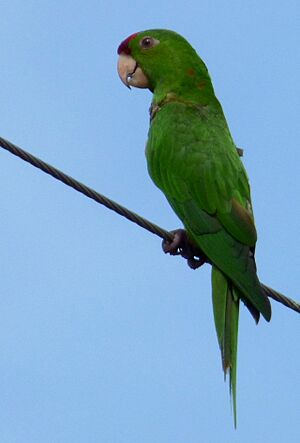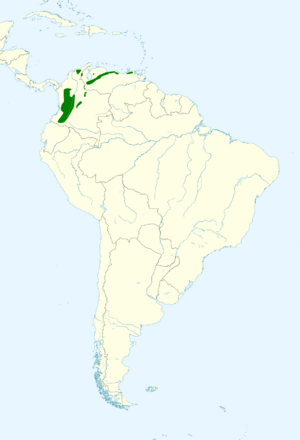Scarlet-fronted parakeet facts for kids
Quick facts for kids Scarlet-fronted parakeet |
|
|---|---|
 |
|
| Conservation status | |
| Scientific classification | |
| Genus: |
Psittacara
|
| Species: |
wagleri
|
 |
|
| Synonyms | |
|
Aratinga wagleri |
|
The scarlet-fronted parakeet (Psittacara wagleri) is a colorful bird that lives in Colombia and Venezuela. People sometimes call it the scarlet-fronted conure, red-fronted conure, or Wagler's conure. This parakeet is considered a Near Threatened species, which means its population is decreasing and it needs protection. It belongs to the family of African and New World parrots.
Contents
About the Scarlet-fronted Parakeet
What's in a Name?
For a while, scientists placed the scarlet-fronted parakeet in a group called Aratinga. But since about 2013, it has been moved to its current group, Psittacara.
Even now, scientists have different ideas about how to classify this bird. Some groups, like the International Ornithological Committee, say it has two main types, called subspecies. Other groups suggest there are more types. This article follows the idea that there are two main subspecies.
How to Spot a Scarlet-fronted Parakeet
Scarlet-fronted parakeets are about 34 to 40 cm (13 to 16 in) long. They weigh between 162 to 217 g (5.7 to 7.7 oz). Both male and female birds look very similar.
They are mostly green, but their underside is a bit more yellow. Some birds might even have small red spots on their throat. Their name comes from the bright red color on their forehead and the front part of their head.
The feathers under their wings and tail are olive-yellow. They have pale gray eyes with bare gray skin around them. Their beak is horn-colored, and their legs and feet are brownish. One subspecies, P. w. transilis, is a bit smaller and darker. Its red crown doesn't go as far back as the other type. Young birds look like adults but have less red on their heads.
Where Do They Live?
The scarlet-fronted parakeet lives in different areas that are not connected. You can find them in the Andes mountains of Colombia. They also live in the Sierra Nevada de Santa Marta in northern Colombia and near the border with Venezuela. They are also found in western and northern Venezuela.
These birds live in many different places. They like the edges of cloudforests, tropical forests, and forests along rivers. They also live in areas where people have changed the land, like fields, fruit farms, and parks in towns. You can find them from 350 to 2,500 m (1,100 to 8,200 ft) high in the mountains.
Parakeet Behavior
How They Move Around
Scarlet-fronted parakeets in Venezuela move from one place to another during different seasons. We don't know much about their movements in Colombia. They often travel in large groups, flying together.
What Do They Eat?
These parakeets usually look for food high up in the trees. While we don't know everything they eat, we know they enjoy fruits, nuts, and seeds. Sometimes, they might eat crops that farmers grow.
Reproduction and Life Cycle
Scarlet-fronted parakeets build their nests from April to June in Venezuela. In northern Colombia, they nest from December to June. They like to nest together in groups, often finding cracks in cliff faces to lay their eggs.
How They Communicate
These parakeets are very noisy birds! Especially when they are flying, they make a loud, continuous screeching chatter. They also make squeaky notes and screeches, like a "kreee" sound.
Protecting the Scarlet-fronted Parakeet
The IUCN (International Union for Conservation of Nature) has listed the scarlet-fronted parakeet as "Near Threatened." This means their population is shrinking, and their living areas are broken up. We don't know exactly how many of these birds are left.
The main reasons their numbers are going down are:
- Trapping: People sometimes catch them to keep as pets.
- Persecution: Sometimes, people harm them, especially if they eat crops.
- Habitat Loss: The places where they live are disappearing because of changes in how land is used.


